7+ Sample Food Security Proposal
-
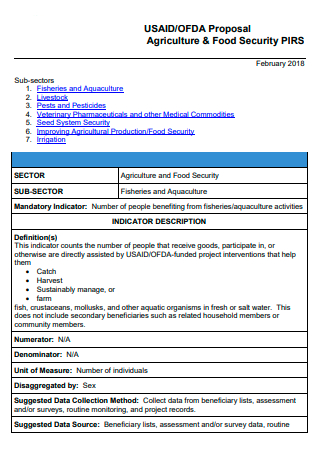
Agriculture and Food Security Proposal
download now -
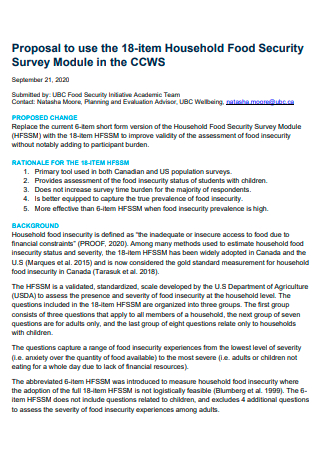
Household Food Security Survey Module Proposal
download now -

Food Security Stream Proposal
download now -
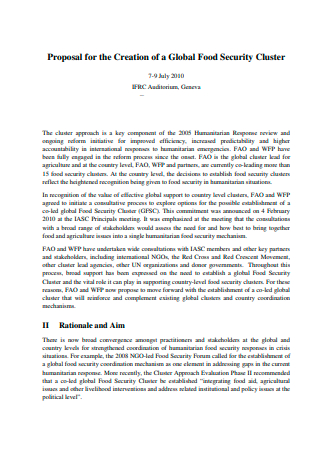
Food Security Cluster Proposal
download now -

Decrease Food Insecurity Proposal
download now -
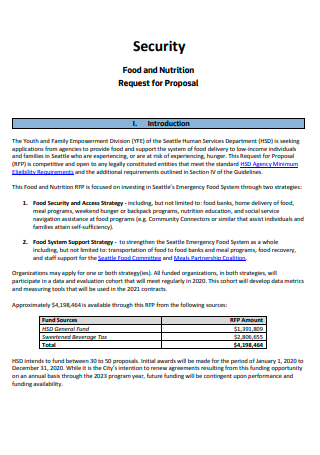
Food and Nutrition Security Proposal
download now -

Food Security Monitoring Proposal
download now -
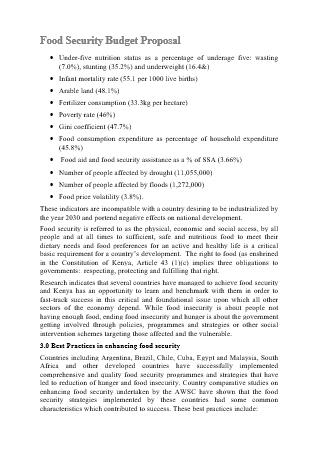
Food Security Budget Proposal
download now
FREE Food Security Proposal s to Download
7+ Sample Food Security Proposal
What Is Food Security Proposal?
What Are the Objectives of the Food Security Proposal for this Pandemic?
Four Dimensions of Food Security
What Are the Ways to Improve Food Insecurity?
Two General Types of Food Insecurity
How to Imply the Steps to Food Safety
FAQs
What Are the Components of Food Security?
How Can Technology Improve Food Security?
How Do You Address Food Security?
Every county and town had to put out their best efforts and labor tirelessly during the spring and summer in order to provide enough food for the winter. Because commerce was still in its infancy, if one did not have access to adequate supplies, he would almost certainly perish. Today, the situation is changed, and the countries may easily purchase or exchange grain, crops, vegetables, and virtually anything else, allowing them to feed their own people. Unfortunately, there are some nations, primarily in the third world, that are experiencing food shortages, and the situation there is truly tragic.
What Is Food Security Proposal?
Food security refers to a country’s ability to provide its population with adequate food for survival. It involves particular institutions, regulations, and policies that are designed to restore normalcy to the food situation under the strict authority of the government. For a healthy human existence, good nutrition and clean drinking water are required as a bare minimum. The issue of food security has always been a pressing and vitally significant one. Centuries ago, people had to put forth a lot of effort to raise crops, vegetables, fruits, and livestock for meat and milk production.
A well-organized research proposal on global food security in the face of climate change should include the historical context of the problem as well as the methods that have been used to solve it in the past. The paper should be persuasive and include original ideas that are tied to a good food security policy. It should also be concise. One must demonstrate that his or her approaches are truly effective and will solve a wide range of difficulties associated with the topic, as well as assist humanity in coping with the global food scarcity crisis. If you are successful in persuading the professor that your topic or notion is worth investigating, you will be given the opportunity to undertake additional research. For any other proposal template need, this website provides the following templates: Proposals for security services, information security proposals, school bus transportation proposals, food safety checklist logistics proposals, research proposals, non-profit partnership proposals, new product proposals, tourism project proposals, and internship proposals are all examples of proposals that can be submitted. The material contained in this post will not only supply you with free templates but will also provide you with essential and relevant information regarding security training.
What Are the Objectives of the Food Security Proposal for this Pandemic?
The spread of the COVID-19 pandemic is wreaking havoc on the lives and food security of rural people, particularly those living in poverty. Food production is jeopardized as a result of a lack of access to supplies, labor, services, and market opportunities. As a result of fluctuating global commodities markets, restrictive trade and border rules, movement limitations, and market closures, food commerce, and distribution networks may be severely harmed in the meanwhile.
- Increasing the ability of small-scale farmers and their organizations to withstand natural disasters is a key component of disaster resilience. In order to accomplish this, alternative agricultural and rural industries must be established quickly, and yields must be maintained and produced in adequate quantities and of excellent quality.
- Increasing access to markets for low-income producers, including safe and hygienic transportation, and working to ensure that markets remain accessible and that demand remains high are all priorities.
- Delivering up-to-date agriculture-related information to small-scale rural producers via digital services, including information on production, weather, market prices, and other vital topics.
- Increasing trade capacity by providing small-scale producers with technologies and services that allow them to fulfill the quality and sanitary criteria of international markets.
Four Dimensions of Food Security
To have food security means that all people, at all times, have physical and economic access to enough safe and nutritious food to suit their dietary needs and food choices in order to live an active and healthy life.
1. Food is readily available on a physical level
Food availability is concerned with the “supply-side” of food security and is governed by the level of food production, the amount of food in-store, and the amount of net trade.
2. Access to Food on a Monetary and Physical Level
Having a sufficient supply of food at the national or international level does not guarantee food security at the home level in and of itself. Due to growing concerns about limited food access, policymakers have shifted their attention away from food production and distribution and toward incomes, expenditure, markets, and prices in the pursuit of food security goals.
3. Utilization of Food
The term “utilization” refers to the process by which the body makes the most of the various nutrients in the food it consumes. Individuals’ ability to obtain sufficient energy and nutrients is a result of appropriate care and feeding habits, food preparation, a diverse diet, and the distribution of food throughout the household, among other factors. The nutritional status of persons is determined by the combination of good biological use of food consumed and the amount of food consumed.
4. Over Time, the Other Three Aspects’ Stability Are Also Examined
Although your current food consumption is sufficient, you are nevertheless regarded to be food insecure if you have insufficient access to food on a regular basis, putting you at risk of deteriorating your nutritional status. Weather extremes, political instability, and economic issues (such as unemployment and rising food prices) all have the potential to have an impact on your food security status.
What Are the Ways to Improve Food Insecurity?
Poverty is the most significant contributor to food insecurity, and it is particularly prevalent in developing countries. It is important to differentiate between chronic undernutrition and chronic malnutrition. According to studies and the opinions of experts, the following are some possible solutions to food insecurity:
- Reduce the amount of food that is wasted.
- Reduce the likelihood of commercialization.
- Existing infrastructure programs should be improved.
- Trade policies should be improved.
- Diversification should be encouraged.
- Close the Yield Gap as soon as possible.
- Put Your Effort Into Combating Climate Change.
Two General Types of Food Insecurity
Seasonal food security is a concept that exists between chronic and transient food insecurity. It is comparable to chronic food insecurity in that it is usually predictable and follows a sequence of circumstances that are well understood. As a result, because seasonal food insecurity is only temporary in nature, it can also be referred to as recurrent, transitory food insecurity. A recurrent pattern of insufficient availability and access to food results in the occurrence of famine. There are seasonal oscillations in the temperature, farming patterns, labor possibilities (labor demand), and disease that contribute to this phenomenon.
How to Imply the Steps to Food Safety
There are only four basic steps to take. Cleaning, separating, cooking, and chilling your food at home can help prevent you and your family from food illness, according to the external symbol.
1. Clean
Germs that cause food poisoning can thrive and spread in a variety of environments, including your kitchen. Hands should be washed with soap and water for 20 seconds before, during, and after preparing meals, as well as before eating. Hot, soapy water should be used to clean your utensils, cutting boards, and surfaces. Fresh fruits and vegetables should be rinsed under running water.
2. Separate
If you don’t keep raw meat, poultry, shellfish, and eggs apart from ready-to-eat meals, they can transfer germs throughout the rest of the kitchen. Raw meat, poultry, and seafood should be served on separate cutting boards and plates. During your grocery shopping, make sure to keep raw meats, poultry, fish, and their liquids separate from the rest of your groceries. The refrigerator should be divided into two sections: one for raw meat and poultry and another for seafood and eggs.
3. Cook
When the interior temperature of the food reaches a degree high enough to kill microorganisms that can make you sick, the food is considered safe to eat. A food thermometer is the only means to determine whether or not food has been safely cooked. By looking at the color and texture of the food, you cannot determine whether it is safe to eat. Use a food thermometer to ensure that foods are cooked to an interior temperature that is safe for consumption.
4. Chill
Keep your refrigerator at 40°F or lower and be aware of when it is time to toss out the food external icon. Perishable foods should be refrigerated within 2 hours of preparation. (If the temperature outside is above 90°F, the food should be refrigerated within 1 hour.) Thaw frozen food in the refrigerator, in cold water, or in the microwave without risking food poisoning. Never thaw meals on the counter because bacteria thrive in the sections of the food that are exposed to room temperature for an extended period of time.
FAQs
What Are the Components of Food Security?
Food insecurity, which is typically founded in poverty, has a negative impact on a country’s ability to develop its agricultural markets and economy. The ability to obtain high-quality, nutritious food is essential for human survival. Secure access to food can have a wide range of beneficial effects, including economic growth and job creation, among other things.
How Can Technology Improve Food Security?
Improved economic growth and social well-being can be achieved through technological advancements such as effective harvest and post-harvest practices to reduce food loss, effective storage and conservation practices to increase the value of harvested products, and the identification of high-value-added products to increase the profits of processors.
How Do You Address Food Security?
It is possible to address this issue through a variety of strategies, including working directly with farmers to improve their harvest and storage facilities, increasing the use of pasteurization and other food preservation techniques, and making infrastructure investments so that the food can be delivered to markets quickly and safely.
The process of developing this proposal is a little challenging, especially because it entails outlining the suitable activities that will be required to attain the desired results and objectives. A fantastic project that an organization might undertake for its people is to raise public awareness about the importance of food security and how to respond in the event that food security is jeopardized. Starting from here, you should begin by developing your idea and presenting it to the appropriate authorities.
